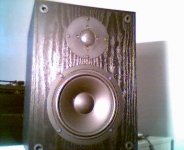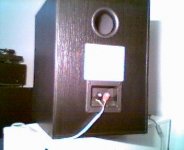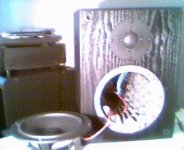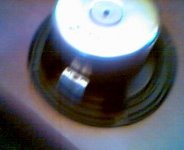i have 2 sets of signet's monitor speaker's new in box
i will post a pick when i get my cam back this thursday
this thursday
sl-16
150 watt
silver dome tweeter
speaker looks to be carbin fiber cone with a black aluminum cage
and a nice beefy spider.rubber surrounds.magnets big with shielding and a decent crossover.inside the monitor its packed with sound foam^^^^and gold binding posts.nicelly ported
tested my set on a zen even at low level sounds great clean highs and lows not boomy
$130+shiping
decent speaker for the buck
karma@cogeco.ca
i will post a pick when i get my cam back
 this thursday
this thursdaysl-16
150 watt
silver dome tweeter
speaker looks to be carbin fiber cone with a black aluminum cage
and a nice beefy spider.rubber surrounds.magnets big with shielding and a decent crossover.inside the monitor its packed with sound foam^^^^and gold binding posts.nicelly ported
tested my set on a zen even at low level sounds great clean highs and lows not boomy
$130+shiping
decent speaker for the buck
karma@cogeco.ca
update no pic yet
The Signets are a straightforward two-way, ported system, featuring an 6.5 inch woofer and a 1 inch dome tweeter. The simple appearance of the cabinets and drivers on the baffle is no indication of the painstaking work the company has put into this design. Signet uses an anti-resonance composite wood. The cabinets are asymmetrically braced for rigidity and to suppress interior standing waves. The woofer's back wave is controlled acoustically to eliminate colouration. The front baffle, which accommodate the drivers, is kept as narrow as possible to help prevent diffraction. Additionally, a patented acoustic damping material called Sonofelt™ is placed around the tweeter. The woofer has a polypropylene cone suspended via a butyl rubber surround in a aluminum die-cast basket. The tweeter is of the Seas aluminum dome variety, mounted on a soft polyamide surround assembly. To help the integration of sound, Signet spaced the woofer and tweeter close together by overlapping the woofer's basket and the tweeter's plate. The system conforms to a bass-reflex design with the tuning port located on the rear of the cabinet and tuned to 40Hz. The crossover divides frequencies at 3000Hz with the help of air-core inductors, polypropylene capacitors, computer-grade printed circuit boards with heavy copper tracing and oxygen-free wiring. Frequency response is quoted from 38Hz to 25kHz. Sensitivity is 88dB, nominal impedance is 8 ohms; all drivers are shielded.
The listening tests were conducted with Topaz, OCM, Bryston and Polyfusion amplifiers, the Opal and Polyfusion preamplifiers wired with Straightwire and Nordost Flatline cables. A Copland and Alchemist CD player/DAC served as source components. Each of the amplifiers has its specific sonic signature with which we are intimately familiar. This sets up ideal conditions to help evaluate loudspeakers as they are introduced to the system(s). A large selection of program material-ranging from Pavarotti to Mighty Sam McLean-was used to test the speakers' versatility. Our panelists had little to criticize and lots to praise. The Signets' imaging proficiency is outstanding and they literally vanish when playing into a listening room (yes, you can still see them). The sl16 offer smooth, but succinct highs, very clear midrange data and rather noteworthy resolving of bass. While deep bass isn't missing entirely, the Signets have restrictions. The all-round sonic impressions, however, do not reveal lack of bass and include oodles of resolution and great tonal balance, in addition to one heck of a sound stage. Our panelists felt that the sl16 are ideal speakers for those who have vacuum tube amplifiers, as a few watts will get them singing. The best system set-up is with the Signets about three to four feet away from the rear and side walls, slightly toed-in.
Whenever we have evaluated Signet loudspeakers, we have been impressed with the company's understanding of what makes a loudspeaker sing. Small loudspeakers always have limited bass response and designers must make a choice. They can opt for the illusion of bass, achieved at the price of unresolved boomy information, or they can be principled and give us designs which resolve bass down to reasonable, fundamental frequencies. The sl16 can be considered conscientious designs which deliver 38Hz with unwavering accuracy and cut unresolved frequencies (from 20 to 40Hz), to eliminate boomy bass. The end result is loudspeakers which provide excellent imagery, transparency in line with more expensive designs and musical authenticity over their specified frequency range. The absence of artificially enhanced bass an be considered a bonus as this doesn't allow the loudspeakers to drone into the listening room. If you are looking to play loud and bass-heavy music, the Signets aren't your kind of speakers. If, on the other hand, you are looking for sonic sophistication at a bargain-basement price, you must try the sl16.
opps not carbon fiber o well still sounds good
The Signets are a straightforward two-way, ported system, featuring an 6.5 inch woofer and a 1 inch dome tweeter. The simple appearance of the cabinets and drivers on the baffle is no indication of the painstaking work the company has put into this design. Signet uses an anti-resonance composite wood. The cabinets are asymmetrically braced for rigidity and to suppress interior standing waves. The woofer's back wave is controlled acoustically to eliminate colouration. The front baffle, which accommodate the drivers, is kept as narrow as possible to help prevent diffraction. Additionally, a patented acoustic damping material called Sonofelt™ is placed around the tweeter. The woofer has a polypropylene cone suspended via a butyl rubber surround in a aluminum die-cast basket. The tweeter is of the Seas aluminum dome variety, mounted on a soft polyamide surround assembly. To help the integration of sound, Signet spaced the woofer and tweeter close together by overlapping the woofer's basket and the tweeter's plate. The system conforms to a bass-reflex design with the tuning port located on the rear of the cabinet and tuned to 40Hz. The crossover divides frequencies at 3000Hz with the help of air-core inductors, polypropylene capacitors, computer-grade printed circuit boards with heavy copper tracing and oxygen-free wiring. Frequency response is quoted from 38Hz to 25kHz. Sensitivity is 88dB, nominal impedance is 8 ohms; all drivers are shielded.
The listening tests were conducted with Topaz, OCM, Bryston and Polyfusion amplifiers, the Opal and Polyfusion preamplifiers wired with Straightwire and Nordost Flatline cables. A Copland and Alchemist CD player/DAC served as source components. Each of the amplifiers has its specific sonic signature with which we are intimately familiar. This sets up ideal conditions to help evaluate loudspeakers as they are introduced to the system(s). A large selection of program material-ranging from Pavarotti to Mighty Sam McLean-was used to test the speakers' versatility. Our panelists had little to criticize and lots to praise. The Signets' imaging proficiency is outstanding and they literally vanish when playing into a listening room (yes, you can still see them). The sl16 offer smooth, but succinct highs, very clear midrange data and rather noteworthy resolving of bass. While deep bass isn't missing entirely, the Signets have restrictions. The all-round sonic impressions, however, do not reveal lack of bass and include oodles of resolution and great tonal balance, in addition to one heck of a sound stage. Our panelists felt that the sl16 are ideal speakers for those who have vacuum tube amplifiers, as a few watts will get them singing. The best system set-up is with the Signets about three to four feet away from the rear and side walls, slightly toed-in.
Whenever we have evaluated Signet loudspeakers, we have been impressed with the company's understanding of what makes a loudspeaker sing. Small loudspeakers always have limited bass response and designers must make a choice. They can opt for the illusion of bass, achieved at the price of unresolved boomy information, or they can be principled and give us designs which resolve bass down to reasonable, fundamental frequencies. The sl16 can be considered conscientious designs which deliver 38Hz with unwavering accuracy and cut unresolved frequencies (from 20 to 40Hz), to eliminate boomy bass. The end result is loudspeakers which provide excellent imagery, transparency in line with more expensive designs and musical authenticity over their specified frequency range. The absence of artificially enhanced bass an be considered a bonus as this doesn't allow the loudspeakers to drone into the listening room. If you are looking to play loud and bass-heavy music, the Signets aren't your kind of speakers. If, on the other hand, you are looking for sonic sophistication at a bargain-basement price, you must try the sl16.
opps not carbon fiber o well still sounds good
- Status
- This old topic is closed. If you want to reopen this topic, contact a moderator using the "Report Post" button.



